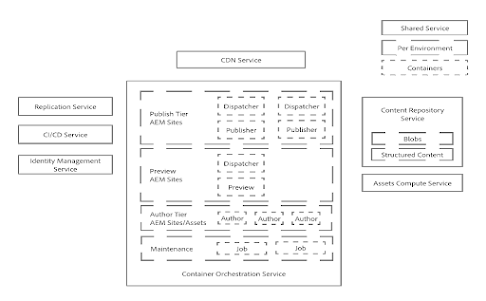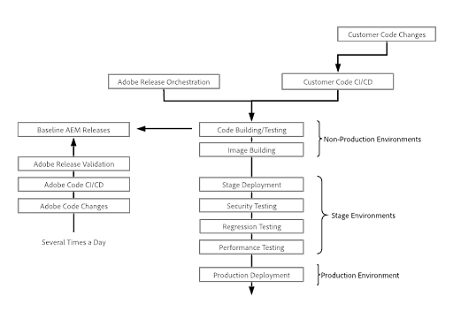AEM as Cloud Service Architecture
Adobe have come up with an innovative cloud-native solution for Adobe Experience Manager (AEM) to solve various challenges involved in scalability, maintenance, content delivery, assets handling & release of new features.
AEM
as Cloud Service is,
·
Always On - Service architecture has been revised so that there
is no downtime for neither content management nor the content delivery
capabilities.
·
Always at Scale - Service architecture will automatically scale
up and down depending on needs.
·
Always Current - It implements a continuous delivery pipeline
for the AEM codebase, with automated updates several times a month keeps the
AEM application up-to date with recent versions.
·
Always Evolving - Based on the projects implemented content,
code & configurations are constantly reviewed against best practices
allowing clients to achieve business goals.
In
AEM On-Premises solution the biggest challenge is to setup production
environment with author & publish instances by considering various
parameters such as traffic, concurrent users, asset handling etc. but in AEM as
Cloud Service with new architecture solves this major problem.
This
architecture,
·
Is scaled based on the actual traffic & user activity.
·
Has individual instances that only run when needed.
·
Uses modular applications.
·
Has an author cluster as default, this avoids downtime for
maintenance tasks.
Scaling
Both
author & publish instances are scalable.
·
Vertical – allocated memory and CPU capacity can be scaled up
or down for a fixed number of nodes.
·
Horizontal – the number of nodes for a given service can be
increased or decreased.
Environments
There
are three types of environments available with AEM as Cloud Service.
1. Production environment –
hosts the application for the business practitioners.
2. Stage environment – Is
always coupled with production in a 1:1 relationship (Both environments uses
same CI/CD pipeline for deployment, where production requires approval).
The stage environment is used for various performance & quality testing.
3. Development environment –
allows developers to implement AEM applications.
Programs
AEM
as Cloud Service offers two types of programs both allows number of features
& functionalities.
1. AEM Cloud Site Service
2. AEM Cloud Assets Service
Each
program will have,
·
1 Adobe managed code repository (Git)
·
1 Stage + Production environment
·
N Development environments
·
1 Deployment & 1 Code Quality Pipeline for Each
Environment
Cloud
Manager
Cloud
Manager is a User Interface (UI), a part of Adobe Managed Cloud Services enables
organization to self-manage Experience Manager in the cloud.
Key
features of Cloud Manager are,
·
Continuous Integration/Continuous Deployment
·
Code Inspection, Performance Testing & Security
Validations
·
Automatic (On Git Changes), Manual & Scheduled Deployment
·
Auto Scaling
·
Configure Programs & Environments
·
Configure SSL Certificates, Domain Settings, IP Allow Lists
Architecture
Runtime
architecture of AEM as Cloud Service is divided into various main components
which are explained as below.
AEM as Cloud Service Runtime Architecture (Courtesy: Adobe)
Author
Tier
·
Author Tier is made up of single author cluster with 2
or more nodes. It scales automatically depending on authoring activity.
·
Content authors login to AEM Author to create, edit &
manage content.
·
Logging into author tier is managed by Adobe "Identity
Management Service" (IMS).
·
“AEM Cloud Assets Service” is enabled in AEM Author. Assets
integration & processing uses a dedicated Assets Compute Service.
Publish
Tier
·
Publish Tier consist of 2 or more nodes with
single publish farm: they can operate independently from each other.
·
Each node consists of a AEM Publish & a web server
equipped with the AEM Dispatcher module. It scales automatically with site
traffic needs.
·
End users or site visitors visit the website via the AEM
Publish Service.
·
AEM Cloud Assets Service is disabled by default.
·
For publish tier, a Content Delivery Network (CDN)
Service is also available at the first entry point.
Preview
Service
·
Preview Service feature delivers an additional Preview
Service to each AEM as Cloud Service environment via Cloud Manager.
·
It allows to Preview website’s final experience before it
reaches Publish Tier & is available publicly.
Common
·
Both Author & Publish Tiers reads &
persists content from/to a Content Repository Service.
·
The Publish Tier only reads content from
persistence layer.
·
The Author Tier reads & writes content
from and to the persistence layer.
·
The blob storage is shared across the Publish
& Author Tiers, files are not moved.
·
Access to Author & Publish Tiers always
happens via a load balancer. This is up to date with active node of each
of the tier.
Replication
Service
·
When content is approved from Author Tier by
activation it will be pushed to the Publish Tier persistence layer. This
happens via "Replication Service" a middle-ware
pipeline.
·
This pipeline receives the new content, with individual
publish service subscribing to the content pushed to the pipeline. For more
information on replication mechanism & setup go through below links.
·
Replication Service uses “Sling Content Distribution” to
move content from Author Tier to Publish Tier [Replication Agents
are no more supported in AEM as Cloud Service].
CI/CD
Service
·
Cloud Manager manages all updates to AEM as Cloud Service.
·
Updates are triggered when
o
A new version of AEM Cloud Service is ready from Adobe.
o
A new version of Customer Application is ready.
·
Cloud Manager pipeline combines new version of Customer
Application + Baseline Adobe Image. When Images are built & tested
successfully, Cloud Manager automates the cut-over to latest version of the
image by updating all the nodes using rolling update pattern.
AEM as Cloud Service Deployment Architecture (Courtesy: Adobe)
Identity
Management Service
·
AEM as a Cloud Service includes Admin Console support for AEM
instances and Adobe Identity Management System (IMS) based authentication.
·
The Admin Console allows admins to centrally manage all
Experience Cloud users.
·
Users and Groups can be assigned to product profiles
associated with AEM as a Cloud Service instances, allowing them to log in to
that instance.
CDN
Service
·
AEM as Cloud Service comes with built-in CDN called “Fastly”.
·
Its main purpose is to reduce latency by delivering cacheable
content from the CDN nodes at the edge.
·
It is fully managed and configured for optimal performance of
AEM applications.
·
Custom Managed CDN are also supported in AEM as Cloud
Service. However, Custom CDN must point to AEM Managed CDN (i.e. Fastly).
References
·
https://docs.adobe.com/content/help/en/experience-manager-cloud-service/operations/replication.html
·
https://sling.apache.org/documentation/bundles/content-distribution.html


Comments
Post a Comment